It looks like you're using an Ad Blocker.
Please white-list or disable AboveTopSecret.com in your ad-blocking tool.
Thank you.
Some features of ATS will be disabled while you continue to use an ad-blocker.
share:
Originally posted by ScientificUAPer
Originally posted by draknoir2
..
And is he not?
Is he to you?
en.wikipedia.org...
www.skymania.com...
Yep.
Until his claims are peer reviewed, and I don't mean his peers in the Journal of Cosmology, that's the most he'll be to me... at least as far as this particular subject is concerned.
edit on 15-1-2013 by draknoir2 because: (no reason given)
Ok, that still doesn't make him 'some guy on the internet' to me. But that's just me.
edit on 15-1-2013 by ScientificUAPer because: (no reason given)
Never mind
edit on 16-1-2013 by Xeven because: (no reason given)
Someone was skeptical of this story because news of it had not been published in any mainstream media sources. I found the article, linked below, in a
South African site called Business Day. It is connected with a South African national newspaper of the same name. I do not believe it qualifies as a
sensationalist tabloid. Business oriented sites and newspapers are typically rather conservative. Link:
bdlive.co.za...
edit on 17-1-2013 by Ross 54 because: corrected name of
website
edit on 17-1-2013 by Ross 54 because: added information
edit on 17-1-2013 by Ross 54 because: omitted
incorrect capitalization
Originally posted by Ross 54
Someone was skeptical of this story because news of it had not been published in any mainstream media sources. I found the article, linked below, in a South African site called Business Day. It is connected with a South African national newspaper of the same name. I do not believe it qualifies as a sensationalist tabloid. Business oriented sites and newspapers are typically rather conservative. Link: bdlive.co.za...edit on 17-1-2013 by Ross 54 because: corrected name of websiteedit on 17-1-2013 by Ross 54 because: added informationedit on 17-1-2013 by Ross 54 because: omitted incorrect capitalization
Same original source: The Journal of Cosmology.
That's unavoidable at this point. It's been less than three weeks since the meteorite reportedly fell. Independent examination of the specimens will
take some time. I'm willing to wait and see if the original claim can be confirmed.
Forget about where the rock came from and look at the Diatom, it's a known terrestrial species... the chances that some extra-terrestrial species
followed an identical evolutionary path would be astronomical.
....and that rock isn't a meteorite. The claim is that it's a Carbonaceous chondrite but there's no way that crumbly chunk of porous rock is a meteorite.
....and that rock isn't a meteorite. The claim is that it's a Carbonaceous chondrite but there's no way that crumbly chunk of porous rock is a meteorite.
edit on 17-1-2013 by Blarneystoner because: (no reason given)
Those were the points raised by Dr. Phil Plait in his recent blog at Slate. I read it in full. The biologist he consulted, apparently working only
from the published photographs, thought the organisms looked too similar to Earthly diatoms to be from anywhere else. He did not specify any
particular species Are we supposed to be able to know in advance how familiar or strange single-celled organisms from another planet will look? What
about the possibilities of convergent evolution, on a planet with environmental conditions not too different from our own?
The claim that the object isn't a meteorite is on even weaker ground. Dr. Plait admits that he is not an expert on meteorites. He apparently didn't consult anyone who is such an expert, either. He compared the alleged meteorite to a typical carbonaceous chondrite, the type of meteor this is supposed to be. Its admittedly not a good match. I was, however, able, after a few minutes search in the Google image files, using the search terms 'carbonaceous chondrite' to find a picture of one of these that *did* look very much like the Sri Lankan meteorite. It seems that Dr. Plait was in an undue haste to dismiss this discovery.
The claim that the object isn't a meteorite is on even weaker ground. Dr. Plait admits that he is not an expert on meteorites. He apparently didn't consult anyone who is such an expert, either. He compared the alleged meteorite to a typical carbonaceous chondrite, the type of meteor this is supposed to be. Its admittedly not a good match. I was, however, able, after a few minutes search in the Google image files, using the search terms 'carbonaceous chondrite' to find a picture of one of these that *did* look very much like the Sri Lankan meteorite. It seems that Dr. Plait was in an undue haste to dismiss this discovery.
edit on 17-1-2013 by Ross 54 because: added information
Originally posted by Blarneystoner
Forget about where the rock came from and look at the Diatom, it's a known terrestrial species... the chances that some extra-terrestrial species followed an identical evolutionary path would be astronomical.
His theory is that amoeba come from space, and that is their origin on earth. He believes earth was seeded by meteors. That's what cometary panspermia means and that is why he wrote the paper. In his model, the earth species did not start its evolutionary path here.
Also, if we look at this collection of Diatoms. We see plenty of triangular shaped species. Are you suggesting that something triangular could only evolve on earth? What is it about earth which makes it the only possible source of triangular looking species? afaik triangles are part of the universal laws of numbers and mathematics..
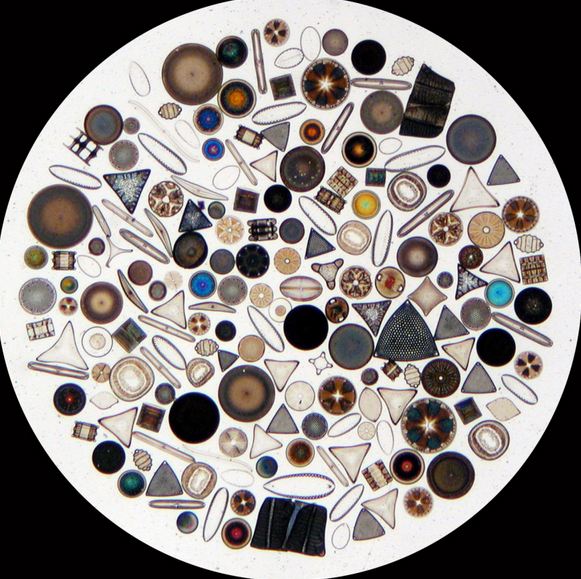
Originally posted by Blarneystoner
....and that rock isn't a meteorite. The claim is that it's a Carbonaceous chondrite but there's no way that crumbly chunk of porous rock is a meteorite.
Really? Here's the original image:
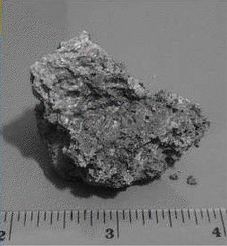
And these carbonaceous meteors look pretty crumbly and similar to me:

Via NASA astrobiology:
www.nasa.gov...
"This meteorite formed when two asteroids collided," said Dr. Daniel Glavin of NASA’s Goddard Space Flight Center, Greenbelt, Md. "The shock of the collision heated it to more than 2,000 degrees Fahrenheit, hot enough that all complex organic molecules like amino acids should have been destroyed, but we found them anyway." Glavin is lead author of a paper on this discovery appearing December 15 in Meteoritics and Planetary Science. "Finding them in this type of meteorite suggests that there is more than one way to make amino acids in space, which increases the chance for finding life elsewhere in the Universe."
Amino acids are used to make proteins, the workhorse molecules of life, used in everything from structures like hair to enzymes, the catalysts that speed up or regulate chemical reactions. Just as the 26 letters of the alphabet are arranged in limitless combinations to make words, life uses 20 different amino acids in a huge variety of arrangements to build millions of different proteins. Previously, scientists at the Goddard Astrobiology Analytical Laboratory have found amino acids in samples of comet Wild 2 from NASA’s Stardust mission, and in various carbon-rich meteorites. Finding amino acids in these objects supports the theory that the origin of life got a boost from space -- some of life’s ingredients formed in space and were delivered to Earth long ago by meteorite impacts.
www.meteorite-times.com...
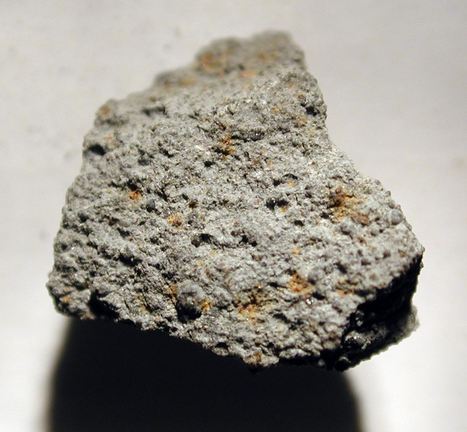
www.meteoris.de...
reply to post by Blarneystoner
The fact that it looks like other terrestrial species ignores the fact that there are only so many shapes micro organisms can take.
It also ignores the supposition that micro-life rained down on earth and somewhere in the vast reaches of the universe is where our earthly micro bugs came from.
If micro-organisms do rain down from comets via meteorites, the question remains where/how did life originate? Call a priest or a good sci-fi author (not that there's a huge difference)!
Edit: It may well be that life appeared here AND there.
The fact that it looks like other terrestrial species ignores the fact that there are only so many shapes micro organisms can take.
It also ignores the supposition that micro-life rained down on earth and somewhere in the vast reaches of the universe is where our earthly micro bugs came from.
If micro-organisms do rain down from comets via meteorites, the question remains where/how did life originate? Call a priest or a good sci-fi author (not that there's a huge difference)!
Edit: It may well be that life appeared here AND there.
edit on 1/18/2013 by Baddogma because: One more idea thingy
edit on
1/18/2013 by Baddogma because: morning idea clarification
edit on 1/18/2013 by Baddogma because: were to where
Originally posted by Baddogma
reply to post by Blarneystoner
The fact that it looks like other terrestrial species ignores the fact that there are only so many shapes micro organisms can take.
If it looks like a duck, quacks like a duck and walks like a duck... it must be a duck.
Occam's razor my friend.... the most likely explanation is that it originated from Earth and not outer space.
It also ignores the supposition that micro-life rained down on earth and somewhere in the vast reaches of the universe is were our earthly micro bugs came from.
It should be ignored because it's speculation but that brings up a good point. Wickramasinghe is a collaborator of Fred Hoyle's (speaking of science fiction writers) . Hoyle and Wickramasinghe are both long time proponents of the Panspermia theory. I can only imagine how thrilled Wickramasinghe was to find "evidence" that supports the Panspermia theory. Okay.... until independent analysis is conducted that confirms the findings, I'm not buying it and apparently no one else is either.
If micro-organisms do rain down from comets via meteorites, the question remains where/how did life originate? Call a priest or a good sci-fi author (not that there's a huge difference)!
Just more speculation.... look... I actually subscribe to the idea that life may have originated from somewhere other than Earth but this type of thing only discredits those who are looking for solid concrete evidence.
reply to post by Blarneystoner
Agreed. Just more noise until properly peer reviewed.
Interesting fodder nonetheless.
Agreed. Just more noise until properly peer reviewed.
Interesting fodder nonetheless.
Occam's razor has been invoked a few times, in remarks about this case. It can be stated as: We know that diatoms exist on Earth, we don't know of
any *not* from Earth. The simplest explanation is Earthly contamination. The simplest explanation is only the best one, if it covers all the facts.
It's not clear that this is the case here. It is reported that the diatoms are mineralized, and in a way very similar to the body of the meteorite.
If this is correct, they are fossils. To maintain the 'simple' hypothesis of Earthly contamination, an entirely new mechanism of fossilization would
have to be supposed. One that can turn living things to stone, inside a rock, in a matter of days.
Originally posted by Ross 54
Occam's razor has been invoked a few times, in remarks about this case. It can be stated as: We know that diatoms exist on Earth, we don't know of any *not* from Earth. The simplest explanation is Earthly contamination. The simplest explanation is only the best one, if it covers all the facts. It's not clear that this is the case here. It is reported that the diatoms are mineralized, and in a way very similar to the body of the meteorite. If this is correct, they are fossils. To maintain the 'simple' hypothesis of Earthly contamination, an entirely new mechanism of fossilization would have to be supposed. One that can turn living things to stone, inside a rock, in a matter of days.
Might be a good idea to independently verify it as a genuine meteorite first. It's not contamination if it's intrinsic to the rock.
I agree, everything about this discovery will need to be independently confirmed. At the moment, it seems, there is an overly hasty tendency to
dismiss it out of hand, and with only the thinnest of justifications. I hope to see meteorite experts and biologists give there best efforts to fairly
examining the evidence.
edit on 18-1-2013 by Ross 54 because: (no reason given)
Originally posted by Ross 54
Occam's razor has been invoked a few times, in remarks about this case. It can be stated as: We know that diatoms exist on Earth, we don't know of any *not* from Earth. The simplest explanation is Earthly contamination. The simplest explanation is only the best one, if it covers all the facts. It's not clear that this is the case here. It is reported that the diatoms are mineralized, and in a way very similar to the body of the meteorite. If this is correct, they are fossils. To maintain the 'simple' hypothesis of Earthly contamination, an entirely new mechanism of fossilization would have to be supposed. One that can turn living things to stone, inside a rock, in a matter of days.
Or... the meteorite... if it is in fact a meteorite... originated from Earth.
many variables to consider.
edit on 18-1-2013 by Blarneystoner because: (no reason given)
I'm familiar with rocks blown off the Moon or Mars by asteroid impacts, that end up on Earth as meteorites. I've never heard of a rock blown off
Earth and returning to it again. They can usually tell where a meteorite has come from by its chemical and/or isotopic composition. They should apply
the tests necessary to determine this to the object from Sri Lanka.
There is a very sceptical article by Phil Plait of Slate here:
www.slate.com...
He spoke to Patrick Kociolek, a professor of ecology and evolutionary biology at the University of Colorado at Boulder who said:
He sounds pretty sure that the diatoms shown are a known earth species and that their origin is freshwater contamination. He also references the remarkably good condition of the diatoms, saying they show no sign of fossilisation.
So what does a real fossilised diatom look like? Presumably usually structurally compromised, if we follow Kociolek's reasoning?
Here are some pictures of many million year old fossilised diatoms:
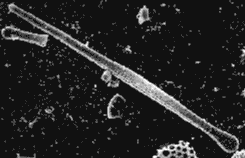

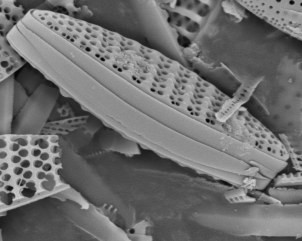
These look remarkably intact to me, but Kociolek seems certain of his own mind.
So, then, Phil Plait mirrors Blarneystoner by speculating this is not a real meteorite and says that it doesn't look anything like a carbonaceous chrondrite.
But on the same date, following widespread reports of bright lights falling over Sri Lanka, farmers are picking these rocks out of their fields.


Jump to 66 seconds to see the farmers. Also note there is a Sri Lankan NASA guy at the start explaining what the bright lights these people saw are.
Maybe I'm giving these farmers too much credit, but I have a feeling these people might know which rocks are and aren't naturally from the fields they've been manually working their whole lives. The health ministry of Sri Lanka has gone as far as to tell people not to touch these 'unidentified particles'.
And in the comments section below the Slate article we see:

So, in addition to Wickramasinghe's cavalier approach to forming conclusions, I see plenty of sceptics, (some being paid to be so) making conclusive, authoritative statements without real evidence either way. Same ole
www.slate.com...
He spoke to Patrick Kociolek, a professor of ecology and evolutionary biology at the University of Colorado at Boulder who said:
I should say up front, that most (not all) of the forms pointed out in the paper are indeed diatoms. While the authors may have not referred to some of the images correctly (labeling one as “filamentous” when it is just a fragment of a cell), they are indeed diatoms.
What is amazing about the forms illustrated is that 1) they are, for the most part, in great shape. There certainly is not any sign of this being fossilized material.
In fact on page 8 of the journal, the authors indicate, “fossils [sic] diatoms were not present near the surface of the Earth to contaminate a new fall of meteorites.” What must have been near, however, was water, since the forms are all freshwater species…
2) the diversity present in the images represent a wide range of evolutionary history, such that the “source” of the diatoms from outer space, must have gone through the same evolutionary events as here on earth. There are no extinct taxa found, only ones we would find living today…for me it is a clear case of contamination with freshwater.
He sounds pretty sure that the diatoms shown are a known earth species and that their origin is freshwater contamination. He also references the remarkably good condition of the diatoms, saying they show no sign of fossilisation.
So what does a real fossilised diatom look like? Presumably usually structurally compromised, if we follow Kociolek's reasoning?
Here are some pictures of many million year old fossilised diatoms:



These look remarkably intact to me, but Kociolek seems certain of his own mind.
So, then, Phil Plait mirrors Blarneystoner by speculating this is not a real meteorite and says that it doesn't look anything like a carbonaceous chrondrite.
But on the same date, following widespread reports of bright lights falling over Sri Lanka, farmers are picking these rocks out of their fields.


Jump to 66 seconds to see the farmers. Also note there is a Sri Lankan NASA guy at the start explaining what the bright lights these people saw are.
Maybe I'm giving these farmers too much credit, but I have a feeling these people might know which rocks are and aren't naturally from the fields they've been manually working their whole lives. The health ministry of Sri Lanka has gone as far as to tell people not to touch these 'unidentified particles'.
And in the comments section below the Slate article we see:

So, in addition to Wickramasinghe's cavalier approach to forming conclusions, I see plenty of sceptics, (some being paid to be so) making conclusive, authoritative statements without real evidence either way. Same ole
Dr. Kociolek held a chair in diatom studies at the California Academy of Sciences for 20 years. It seems odd that he wouldn't be aware that
microfossils can have very well preserved structures.
He is never quoted by Dr. Plait as having specified any particular terrestrial species of diatoms that the meteorite fossils are supposed to be. I'd have thought that he could and would do so. This would strengthen his contention that the diatoms are terrestrial. If he was more specific than Dr. Plait gives him credit for, why didn't Plait include this information in his blog? To not do so is to throw away the best evidence that what you believe about the diatoms (that they're from Earth) is actually true.
If only a general resemblance to Earthly diatoms was perceived, this is hardly a convincing argument, in itself. A shark resembles a porpoise, if you don't get too specific, that scarcely means that they are both the same sort of creature.
He is never quoted by Dr. Plait as having specified any particular terrestrial species of diatoms that the meteorite fossils are supposed to be. I'd have thought that he could and would do so. This would strengthen his contention that the diatoms are terrestrial. If he was more specific than Dr. Plait gives him credit for, why didn't Plait include this information in his blog? To not do so is to throw away the best evidence that what you believe about the diatoms (that they're from Earth) is actually true.
If only a general resemblance to Earthly diatoms was perceived, this is hardly a convincing argument, in itself. A shark resembles a porpoise, if you don't get too specific, that scarcely means that they are both the same sort of creature.
edit on 18-1-2013 by Ross 54 because: improved
paragraph structure
edit on 18-1-2013 by Ross 54 because: corrected spelling
Dr. Kociolek, objecting that the diatoms in the meteorite did not look fossilized to him, was apparently working solely from the published
photographs. He did not explain how he was able, in this way, to distinguish fossil mineralization, from the mineral (silica) shell that surrounds
living diatoms. It seems that a much more complete range of data would be needed to do this.
new topics
-
whistleblower Captain Bill Uhouse on the Kingman UFO recovery
Aliens and UFOs: 3 hours ago -
1980s Arcade
General Chit Chat: 5 hours ago -
Deadpool and Wolverine
Movies: 6 hours ago -
Teenager makes chess history becoming the youngest challenger for the world championship crown
Other Current Events: 7 hours ago -
CIA botched its handling of sexual assault allegations, House intel report says
Breaking Alternative News: 8 hours ago -
Lawsuit Seeks to ‘Ban the Jab’ in Florida
Diseases and Pandemics: 10 hours ago
top topics
-
Lawsuit Seeks to ‘Ban the Jab’ in Florida
Diseases and Pandemics: 10 hours ago, 20 flags -
Starburst galaxy M82 - Webb Vs Hubble
Space Exploration: 12 hours ago, 12 flags -
The Superstition of Full Moons Filling Hospitals Turns Out To Be True!
Medical Issues & Conspiracies: 14 hours ago, 8 flags -
CIA botched its handling of sexual assault allegations, House intel report says
Breaking Alternative News: 8 hours ago, 8 flags -
whistleblower Captain Bill Uhouse on the Kingman UFO recovery
Aliens and UFOs: 3 hours ago, 6 flags -
15 Unhealthiest Sodas On The Market
Health & Wellness: 13 hours ago, 5 flags -
Teenager makes chess history becoming the youngest challenger for the world championship crown
Other Current Events: 7 hours ago, 3 flags -
Deadpool and Wolverine
Movies: 6 hours ago, 3 flags -
1980s Arcade
General Chit Chat: 5 hours ago, 3 flags
active topics
-
They Killed Dr. Who for Good
Rant • 61 • : Cymru -
How ageing is" immune deficiency"
Medical Issues & Conspiracies • 26 • : RookQueen2 -
The Democrats Take Control the House - Look what happened while you were sleeping
US Political Madness • 105 • : SchrodingersRat -
Starburst galaxy M82 - Webb Vs Hubble
Space Exploration • 4 • : SchrodingersRat -
Non-Human Operate Within The Visual Spectrum 'We Cannot See' - ULTRATERRESTRIALS EXIST!
Paranormal Studies • 136 • : burritocat -
New whistleblower Jason Sands speaks on Twitter Spaces last night.
Aliens and UFOs • 39 • : RookQueen2 -
23,000 Dead People Registered Within a Two Week Period In One State
US Political Madness • 39 • : Audreagassulke -
1980s Arcade
General Chit Chat • 7 • : Freeborn -
Europe declares war on Russia?
World War Three • 59 • : Freeborn -
George Knapp AMA on DI
Area 51 and other Facilities • 38 • : theshadowknows

